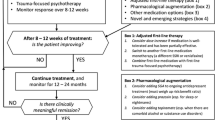Abstract
Posttraumatic stress disorder (PTSD) symptoms may improve significantly with antidepressant medications, however some phenomena often remain refractory to the most commonly used treatments. Frequently, sleep disturbances, such as insomnia and nightmares, are symptoms of PTSD that are refractory to antidepressant treatment. Gabapentin, a novel anticonvulsant agent, has been of interest as a potential anxiolytic agent, but has not been evaluated in PTSD. We reviewed records of 30 consecutive patients who had been diagnosed with PTSD according to structured interviews and had received gabapentin as an adjunctive medication. For each patient, the target symptoms that led to the initiation of gabapentin treatment were identified. Using the most recent clinical data available, the change in target symptom severity following treatment was rated as unimproved, mildly improved, moderately improved, or markedly improved. The gabapentin was often first prescribed to facilitate sleep. The majority (77%) of patients showed moderate or greater improvement in duration of sleep, and most noted a decrease in the frequency of nightmares. The dose range was 300–3600 mg/day. Sedation and mild dizziness were the most commonly reported side effects. This retrospective study suggests that gabapentin may improve in particular sleep difficulties and also other symptoms associated with chronic PTSD. Prospective, controlled studies are needed to further investigate the effects of gabapentin on insomnia, nightmares, and other core PTSD symptoms.
Similar content being viewed by others
REFERENCES
Foa EB, Davidson JRT, Frances A, Culpepper L, Ross R, Ross D (eds): The expert consensus guideline series: Treatment of posttraumatic stress disorder. J Clin Psychiatry 1999; 60 (Suppl. 16):4–76
Brady KT, Pearlstein T, Asnis GM, Barker D, Rothbaum B, Sikes CR, Farfel GM: Efficacy and safety of sertraline treatment of posttraumatic stress disorder: A randomized controlled trial. JAMA 2000; 283:1831–1844
Connor KM, Sutherland SM, Tupler LA, Malik ML, Davidson JR: Fluoxetine in post-traumatic stress disorder: Randomized, double-blind study. Br J Psychiatry 1999; 175:17–22
van der Kolk BA, Drefuss D, Michaels M, Shera D, Berkowitz R, Fisler R, Saxe G: Fluoxetine in posttraumatic stress disorder. J Clin Psychiatry 1994; 55:517–522
Hertzberg MA, Feldman ME, Beckham JC, Kudler HS, Davidson JR: Lack of efficacy for fluoxetine in PTSD: A placebo controlled trial in combat veterans. Ann Clin Psychiatry 2000; 12:101–105
Friedman MJ, Southwick SM: Towards pharmacotherapy for post-traumatic stress disorder. In: Freidman MJ, Charney DS, Deutch AY, eds. Neurobiological and Clinical Consequences of Stress: From Normal Adaptation to PTSD. Philadelphia: Lippincott-Raven; 1995; 465–81
Keck PE Jr, McElry SL, Friedman LM: Valproate and carbamazepine in the treatment of panic, posttraumatic stress disorders, withdrawal states, and behavior dyscontrol syndromes. J Clin Pyschopharmacol 1992; 12(Suppl. 1):36S-41S
Hamner MB, Frueh BC, Ulmer HG, Huber MG, Twomey TJ, Tyson C, Arana GW: Psychotic features in chronic posttraumatic stress disorder and schizophrenia. J Nerv Ment Dis 2000; 1888:217–221
Fesler FA: Valproate in combat-related posttraumatic stress disorder. J Clin Psychiatry 1991; 52:361–364
Clark RD, Canive JM, Calais LA, Qualls CR, Tuason VB: Divalproex in posttraumatic stress disorder: An open-label clinical trial. J Trauma Stress 1999; 12:395–401
Szymanski HV, Olympia J: Divalproex in posttraumatic stress disorder. Am J Psychiatry 1991; 148:1086–1087
Hertzberg MA, Butterfield MI, Feldman ME, Beckham JC, Sutherland SM, Connor KM, Davidson JR: A preliminary study of lamotrigine for the treatment of posttraumatic stress disorder. Biol Psychiatry 1999; 45:1226–1229
Pande AC, Davidson JRT, Jefferson JW, Janney CA, Katzelnick CA, Weisler RH, Griest JH, Sutherland SM: Treatment of social phobia with gabapentin: A placebo-controlled study. J Clin Psychopharm 1999; 19:341–348
Crockatt JG, Greiner M, Clift LL, Pande AC: Treatment of panic disorder with gabapentin. NCDEU 1998: Abstract No. 154
Pande AC, Pollack MH, Crockatt MA, Greiner M, Chouinard G, Lydiard RB, Taylor CB, Dager SR, Shiovitz T: Placebo-controlled study of gabapentin treatment of panic disorder. J Clin Psychopharm 2000; 20:467–471
Brannon N, Labbate L, Huber M: Gabapentin treatment for posttraumatic stress disorder (letter). Can J Psychiatry 2000; 45:84
American Psychiatric Association: Diagnostic and Statistical Manual of Mental Disorders, (DSM-IV), 4th ed. Washington DC: American Psychiatric Association; 1994
Blake D, Weather F, Nagy L, Kaloupek D, Klauminzer G, Charney D, Keane T: A clinician rating scale for assessing current and lifetime PTSD: The CAPS 1. Behav Ther 1990; 18:187–188
Keane Tm, Caddell JM, Taylor KL: Mississippi Scale for Combat-Related Posttraumatic Stress Disorder: Three studies in reliability and validity. J Consult Clin Psychol 1988; 56:85–90
Petroff OA, Rothman DL, Bekahr KL, Lamoureux D, Mattson RH: The effect of gabapentin on release of gamma-aminobutyric acid in patients with epilepsy. Ann Neurol 1996; 39:95–99
Taylor CP, Gee NS, Su TZ, Kocsis JD, Welty DF, Brown JP, Dooley DJ, Boden P, Singh L: A summary of mechanistic hypotheses of gabapentin pharmacology. Epilepsy Res 1998; 29:233–249
Morris GL. Gabapentin. Epilepsia 1999; 40(Suppl. 5):S63–S70
Singh L, Field MJ, Ferris P, Hunter JC, Oles RJ, Williams RG, Woodruff GN. The antiepileptic gabapentin (neurontin) possesses anxiolytic-like properties and antinociceptive actions that are reversed by d-serine. Psychopharmacology 1996; 127:1–9
Southwick SM, Bremner JD, Rasmusson A, Morgan CA III, Arnsten A, Charney DS: Role of norepinephrine in the pathophysiology and treatment of posttraumatic stress disorder. Biol Psychiatry 1999; 46:1192–1204
Hamner MB, Diamond BI, Hitri A: Plasma norepinephrine and MHPG responses to exercise stress in PTSD. In: Murburg MM, ed. Catecholamine Function in Post-Traumatic Stress Disorder: Emerging Concepts. Washington DC: American Psychiatric Press; 1994; 221–232
Mellman TA, Kulick-Bell RL, Kumar A, Nolan B: Sleep and arousal regulation in posttraumatic stress disorder. Sleep Res 1993; 22:153
Author information
Authors and Affiliations
Rights and permissions
About this article
Cite this article
Hamner, M.B., Brodrick, P.S. & Labbate, L.A. Gabapentin in PTSD: A Retrospective, Clinical Series of Adjunctive Therapy. Ann Clin Psychiatry 13, 141–146 (2001). https://doi.org/10.1023/A:1012281424057
Issue Date:
DOI: https://doi.org/10.1023/A:1012281424057




